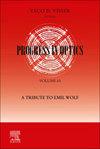Optical Lines in Europium and Terbium-Activated Yttrium Tantalate Phosphor: Combined Experimental and Group-Theoretical Analysis
3区 物理与天体物理
Q1 Materials Science
引用次数: 0
Abstract
The rare-earth ions in crystals such as terbium (YTaO4:Tb3+) and europium (YTaO4:Eu3+)-activated yttrium tantalate phosphors have a number of attractive features that predetermine their crucial role in practical application in contemporary optoelectronic devices. In this article, we employ the group-theoretical arguments aimed to reveal the group-theoretical classification of the crystal field levels and selection rules for the allowed optical transition between the crystal field components of Tb3+ and Eu3+ of the low symmetry crystal field in the activated yttrium tantalate phosphors. We also establish possible polarization rules for the lines corresponding to the allowed transitions. We deduce the symmetry-assisted results for the selection rules in the optical transitions accompanied by the absorption/emission of the vibrational quanta. The selection rules for the vibronic satellites of the zero-phonon lines are expected to be useful for the identification of the lines in the spectra of rare-earth ions with a weak vibronic coupling. The results of the low-temperature measurements of photoluminescence under the 325 nm excitation are in compliance with the group-theoretical analysis. The aim of the paper is to establish symmetry-assisted results that are the background of the quantitative crystal field theory based on the quantum-mechanical consideration.铕和铽活化的钽酸钇荧光粉中的光谱线:结合实验和群理论分析
铽(YTaO4:Tb3+)和铕(YTaO4:Eu3+)活化的钽酸钇荧光粉晶体中的稀土离子具有许多吸引人的特征,这些特征预先决定了它们在当代光电器件实际应用中的关键作用。在本文中,我们采用群论论点,旨在揭示激活钽酸钇荧光粉中低对称性晶体场中Tb3+和Eu3+的晶体场组分之间允许的光学跃迁的群论分类和选择规则。我们还建立了与允许跃迁相对应的谱线的可能极化规则。我们推导了伴随振动量子的吸收/发射的光学跃迁中选择规则的对称性辅助结果。本文提出的零声子谱线的振动卫星选择规则,有望为弱振动耦合稀土离子谱线的识别提供参考。在325 nm激发下的低温光致发光测量结果符合群论分析。本文的目的是建立对称辅助结果,这是基于量子力学考虑的定量晶体场理论的背景。
本文章由计算机程序翻译,如有差异,请以英文原文为准。
求助全文
约1分钟内获得全文
求助全文

 求助内容:
求助内容: 应助结果提醒方式:
应助结果提醒方式:


